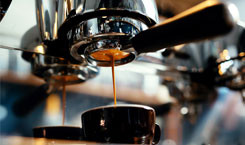Portafilter machine
The portafilter machine is probably the best known and most respected way of preparing espresso. In contrast to the fully automatic coffee maker, the most important thing about the portafilter machine is what its Italian inventors call mano. Mano is Italian for hand and stands for the human factor in the traditional preparation of espresso, in short for the craft. If you are interested in learning the traditional art of the barista and want to make a really good espresso, there is no way around a sieve holder.
The origins of the portafilter machine
Until the end of the 19th century, the preparation of coffee by printing was unknown. Coffee was usually brewed by passing water through the coffee and coffee filters by gravity. Preparation with a French press or a Karlsbader pot was also common. However, all these methods shared the same problem: preparation took a long time. Up to four minutes per cup of coffee.
In a world that was fundamentally changed and accelerated by industrialization, something new was needed. In the early years of the last century, Italians such as Moriondo and Bezzera finally experimented with steam, inspired by various steam engines. For example, the first machines that had an actual portafilter more or less continuously produced coffee, which ran through a screen using the steam pressure of the water brought to the boil in the kettle.
As the inclined espresso fan knows, a temperature of 100°C and more, like boiling water, is far too hot for a really good espresso. The results produced by the new machines were therefore sub-optimal.
The first machine to overcome this overheating problem was developed by Cremosi in 1938 and finally built by Achille Gaggia. Not by steam pressure but by the mechanical tension of a steel spring, which was pretensioned with a hand lever, the water was now pressed through the sieve at a continuous pressure of ten bar. The water could flow through the coffee grounds at an optimum temperature of 90 - 95 °C. The water was then pressed through the sieve with a hand lever. The result was convincing in every respect and the hand lever machine was born, which today functions according to the same principle.
The Portafilter
The supreme discipline of the barista is preparation using a bottomless hand lever machine. Bottomless describes the fact that no Chanelling takes place when the espresso flows out of the sieve, any unevenness during pressing or grinding is immediately noticeable when brewing. If you would like to try this out, you can buy bottomless strainer carriers for most strainer carrier machines.
The right portafilter machine
If you want to buy a portafilter machine, you should carefully consider in advance what demands are made on the machine. Is comfort or tradition desired, must the machine prepare as many espressos as possible or just one? And then, of course, there is the question of price. There are mainly two types of screen carrier machines:
Hand lever machines
The traditional way of preparing espresso is of course done in a hand lever machine with a sieve carrier. In order to master this machine, however, you have to deal with various factors; unlike a fully automatic machine, you have to inform yourself about the degree of grind, the amount of coffee, the amount of water and some other things. The hand levers are nice to look at and an eye-catcher in every kitchen, but you need a little muscle power and anyone who has worked as a barista on a hand lever machine knows that this can be exhausting. However, those who are interested in espresso and above all the associated craft and are willing to invest a little time are well advised to use a hand lever machine. The operation is fun in any case.
Electric portafilter machine
Of course, you should also read a bit into the preparation of a good espresso with electric portafilter machines. Coffee quantity and grind must also be set correctly. However, most electric machines regulate the pressure, the amount of water and the temperature all by themselves. With the help of a small electric vibration or rotary pump, the water is reliably pressed through the sieve at the right pressure. The water then starts to flow either at the push of a button or through a valve. With this type of machine, it should be noted that vibration pumps can make a lot of noise, especially in low-priced machines, and therefore do not necessarily fit in every office.
With both types of machines you can choose the size according to your needs. For home use, a small machine with a single sieve carrier and a 300-500 ml tank is usually sufficient. For the catering industry, there are machines with 4 or more portafilter, fixed water connections, double boilers and integrated descaling. For espresso enthusiasts, it's worth consulting the relevant book, because espresso machines can fill entire volumes!

